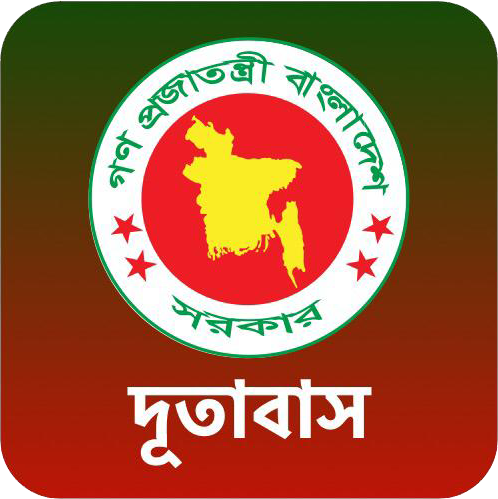Bangladesh at a glance
Bangladesh is Located in the north-eastern part of South Asia. The majestic Himalayas stand some distance to the north, while in the south lays the Bay of Bengal. West Bengal borders on the west and in the east lies the hilly and forested regions of Tripura, Mizoram (India) and Myanmar. These picturesque geographical boundaries frame a low lying plain of about 1,47,570 square kilometer, criss-crossed by innumerable rivers and streams. Mighty rivers are Padma (Ganges), Brahmaputra (Jamuna), Meghna and Karnafuli.
Bangladesh offers many tourist attractions, including archaeological sites, historical mosques and monuments, longest natural beach in the world, picturesque landscape, hill forests and wildlife, rolling tea gardens and tribes. The rich flora and fauna and colorful tribal life is very enchanting. Each part of the country offers distinctly different topography, flavors and delicacies. It is home to the Royal Bengal Tiger, freshwater pink dolphins, historical temples made of red earth.
Some of popular known tourist attractions are: Srimangal, where miles of tea gardens are located, Mainamati, Mahasthangarh, Paharpur for archaeology, Rangamati, Kaptai and Cox’s Bazar for sight seeing, and the Sundarbans for wild life and the largest Mangrove forest of the world, and, Foy’s Lake for scenic beauty. To know more about tourism of activities in Bangladesh.
Bangladesh-Fast Facts
Official Name: People’s Republic of Bangladesh
Nationality: Bangalees as a nation and Bangladeshi as citizen.
Weekends: Friday & Saturday, some govt and non-govt offices remain open on Saturdays.
International Dialing Code: +880Standard Time : BST (GMT +6 Hours)
Capital City
Dhaka
Demography
Population: 15.02 crores
Male : 7.635 crores
Female : 7.615 crores
Literacy Rate: 60%
Language
Bangla (national language) spoken by 95%
English is widely understood and spoken.
Religion
Muslims – 86.6%,
Hindus – 12.1%,
Buddhists – 0.6%,
Christians -0.4%,
Others -0.3%.
Age Structure
0-14 years: 33.8% (male 23,069,242: female 21,995,457)
15-64 years: 62.8% (male 42,924,778; female 40,873,077)
65 years and over: 3.4% (male 2,444,314; female 2,069,816)
Population Growth Rate: 1.37%
Birth Rate / 1000 : 25.12 births/1,000 population
Death Rate / 1000 : 8.47 deaths/1,000 population
Gender
Sex Ratio (males per 100 females): 100.3
Fertility Rate: 2.30 children born/woman
Ethnic Groups
Bengalis (98%)
Other small ethnic groups (2%) including Chakma, Marma, Santal, Garo, Manipuri, Tripura, and Tanchangya.
Geography
Geographical Location:
Latitude between 20 degree 34′ and 26 degree 38′ North
Longitude between 88 degree 01′ and 92 degree 41′ East
Area: 147,570 sq. km. (land: 133,910 sq km, water: 10,090 sq km)
Boundaries:
North – India (West Bengal and Meghalaya)
West – India (West Bengal)
East – India (Tripura and Assam) and Myanmar
South-Bay of Bengal.
Total: 4,246 km (border countries: Burma 193 km, India 4,053 km)
Coastline: 580 km
Maritime boundary:
Contiguous zone: 18 nm
Continental shelf: up to the outer limits of the continental margin
Exclusive economic zone: 200 nm
Territorial sea: 12 nmTerrain: Mostly flat alluvial plain; hilly in southeast7 Divisions – Chittagong, Khulna, Sylhet, Rajshahi, Barisal, Rangpur
64 Districts
488 Subdistricts/UpazillasPrincipal Rivers: Padma, Meghna, Jamuna, Surma, Brahmaputra, Karnaphuli, Teesta, Sitalakhya, Rupsha, Madhumati, Gorai, Mahananda etc.
Climate
Climate Variation: Sub-tropical monsoon
Average Temperature:
Winter 11 degree C – 20 degree C (October – February)
Summer 21 degree C – 38 degree C (March – September)Rainfall : 1,100 mm to 3,400 mm (June – August)
Humidity:
Highest 99% (July)
Lowest 36% (December & January)
Economy
Principal Crops: Rice, Jute, Tea, Wheat, Sugarcane, Pulses, Mustard, Potato, Vegetables.
Principal Industries: Garments & Textiles (2nd largest in the world), Tea, Ceramics, Cement, Leather, Jute (largest producer in the world), Chemical, Fertilizer, Shrimp Processing, Sugar, Paper, Electric and Electronics, Medicine, Fishing.
Principal Exports: Garments, Knitwear, Frozen Shrimps, Tea, Leather and Leather products, Jute and Jute products, Ceramics, IT Outsourcing, etc.
Principal Imports: Wheat, Fertilizer, Petroleum goods, Cotton, Edible Oil etc.
Principal Minerals: Natural gas,oil, Coal, white clay, glass sand etc.
Currency:
Taka (BDT)
1000, 500, 100, 50, 20, 10, 5, 2 and 1 in notes and
# 50,25,10,5,1 in coins.
Exchange Rate
Labour Force: 54 million
Male: 38 million
Female: 16 million
Distribution of Labor:
Agriculture: 48.4 percent
Industry: 24.3 percent
Others: 27.3 percent
Transportation Methods: Road, Air, Rail, Waterways (More information)
Export Processing Zones (EPZs): Dhaka, Uttara, Adamjee, Chittagong, Comilla, Ishwardi, Karnaphuli, and Mongla.
Historical Dates
Independence Day: 26th March
Victory Day: 16th December
Martyr’s Day: 21st February (Also recognized as the International Mother Language Day)
Tourism
Places of Tourist Interest:
Dhaka, Chittagong, Cox’s Bazar, Kaptai, Rangamati, Khagrachari, Bandarban, Kuakata, Bogra, Khulna, the Sundarbans, Sylhet, Rajshahi, Dinajpur and Comilla.
Airports:
Dhaka, Chittagong, Sylhet, Jessore, Rajshahi, Saidpur, Barisal and Cox’s Bazar
More Information : Bangladesh Parjatan Corporation.
Information Technology (IT)
Country Domain: .bd
Internet Penetration: 4.46 crores (29% of population)
Mobile Users: 12 crores, 37 lakhs (March 2015), Source: www.btrc.gov.bd
Mobile Penetration: 80% of the population
Global Ranks of Bangladesh
8th largest country in the world in terms of population
4th largest Muslim country in the world in terms of population and 3rd largest Muslim majority country
7th most densely populated country and the most densely populated country in the world having more than 10 million populations (Ref)
Situated on the Ganges Delta, the largest delta in the world and also the largest wetland in the world
Cox’s Bazaar is the longest natural sandy sea beach in world
2nd largest garments exporter in the world
Largest producer of Jute (2nd largely grown vegetable fiber in the world) Sundarbans (hosted by both Bangladesh and India) has the largest mangrove forest in the world
ILO Global Wage Report 2018 mentions that Bangladesh’s gender wage gap is the lowest in the world: 2.2% against global average of 21.2%
Bangladesh ranks 5th globally in political empowerment of women
Bangladesh is the 4th largest producer of rice
Bangladesh is the 5th largest producer of sweet water fish, and the 3rdlargest producer of vegetable.
IMF reports that Bangladesh ranks 34th among 74 Emerging Economies regarding inclusive economic growth






